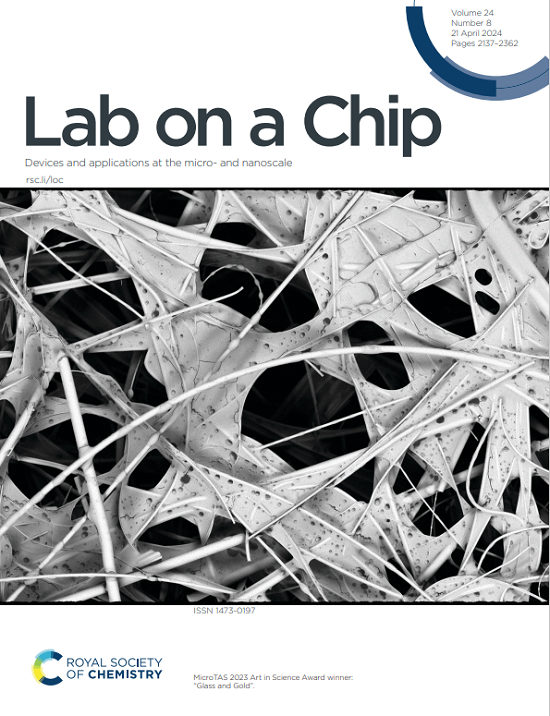Integrated and Turnkey Custom-Built Multiplexed Portable Platform for On-Site Electrochemical Detection
IF 5.4
2区 工程技术
Q1 BIOCHEMICAL RESEARCH METHODS
引用次数: 0
Abstract
A compact and cost-effective device is essential to bring multiplexed biosensing from lab to the point-of-care. Electrochemical sensing has emerged as a powerful choice for developing such lab-on-chip (LOC) platforms, offering good sensitivity, scalability, and compatibility. Potentiostat is a fundamental instrument widely employed in electrochemical sensors for clinical diagnostics, environmental monitoring, immunosensors, toxicity testing, and so on. However, conventional electrochemical workstations are often bulky and expensive, limiting their feasibility for portable, cost-effective biosensing, particularly for multiplexed detection at the point of care. Hence, it is ill-suited for the integration with lab-on-chip systems. This paper presents, a low-cost, portable potentiostat with multiplexed electrochemical biosensing capability and Wi-Fi connectivity designated as µBIOPOT. This operates within a potential window of ±1 V and a current range of ±1 mA, supporting various voltammetric techniques, including Cyclic Voltammetry (CV), Linear Sweep Voltammetry (LSV), Differential Pulse Voltammetry (DPV), Square Wave Voltammetry (SWV), and Normal Pulse Voltammetry (NPV). Its multiplexed capability enables real-time detection of multiple analytes, addressing key challenges in rapid and comprehensive biosensing. Validation of performance is done using the redox probe ferri/ferrocyanide, with results demonstrating close alignment with those obtained with a commercially available conventional potentiostat. Additionally, the device is tested for its ability to detect two key lipid biomarkers—cholesterol and triglycerides, demonstrating its ability for multiplexed detection. User-friendly interfaces provide real-time characteristic plots for research and simplified options for non-experts to determine biomarker concentrations. With Wi-Fi connectivity, low power consumption, and affordability at just $ 36, µBIOPOT represents a scalable, accessible, and efficient solution for the development of multiplexed electrochemical biosensors in both clinical and resource-limited settings.集成和交钥匙定制的多路便携式现场电化学检测平台
要将多路生物传感技术从实验室带到医疗现场,一种紧凑且具有成本效益的设备至关重要。电化学传感已成为开发此类芯片实验室(LOC)平台的有力选择,具有良好的灵敏度、可扩展性和兼容性。恒电位器是一种基础仪器,广泛应用于临床诊断、环境监测、免疫传感器、毒性检测等电化学传感器中。然而,传统的电化学工作站往往体积庞大,价格昂贵,限制了其便携式,具有成本效益的生物传感的可行性,特别是在护理点进行多路检测。因此,它不适合与芯片上的实验室系统集成。本文介绍了一种具有多路电化学生物传感能力和Wi-Fi连接的低成本便携式电位器,命名为µBIOPOT。它可以在±1 V的电位窗口和±1 mA的电流范围内工作,支持各种伏安技术,包括循环伏安法(CV),线性扫描伏安法(LSV),差分脉冲伏安法(DPV),方波伏安法(SWV)和正常脉冲伏安法(NPV)。其多路复用功能可实现多种分析物的实时检测,解决快速和全面生物传感中的关键挑战。使用氧化还原探针铁/亚铁氰化物进行性能验证,结果显示与市售常规恒电位器获得的结果密切一致。此外,该设备还测试了其检测两种关键脂质生物标志物——胆固醇和甘油三酯的能力,证明了其多重检测的能力。用户友好的界面为研究提供实时特征图,并简化了非专家确定生物标志物浓度的选择。µBIOPOT具有Wi-Fi连接,低功耗,价格仅为36美元,为临床和资源有限的环境中开发多路电化学生物传感器提供了可扩展,可访问和高效的解决方案。
本文章由计算机程序翻译,如有差异,请以英文原文为准。
求助全文
约1分钟内获得全文
求助全文
来源期刊

Lab on a Chip
工程技术-化学综合
CiteScore
11.10
自引率
8.20%
发文量
434
审稿时长
2.6 months
期刊介绍:
Lab on a Chip is the premiere journal that publishes cutting-edge research in the field of miniaturization. By their very nature, microfluidic/nanofluidic/miniaturized systems are at the intersection of disciplines, spanning fundamental research to high-end application, which is reflected by the broad readership of the journal. Lab on a Chip publishes two types of papers on original research: full-length research papers and communications. Papers should demonstrate innovations, which can come from technical advancements or applications addressing pressing needs in globally important areas. The journal also publishes Comments, Reviews, and Perspectives.
 求助内容:
求助内容: 应助结果提醒方式:
应助结果提醒方式:


